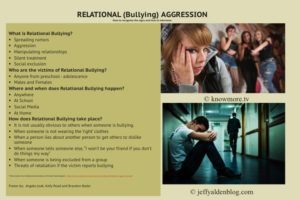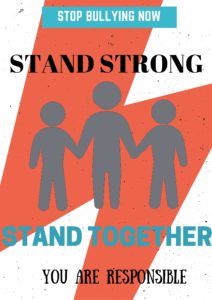 Kelly Read, Angela Leak, Brandon Bader
Kelly Read, Angela Leak, Brandon Bader
Relational Bullying is the opposite of physical bullying, yet just as damaging to self-esteem if not more so. The wounds from physical bullying may fade after time but wounds from relational bullying can last for years if not a lifetime. Some examples of relational bullying are peer pressure, gossip, social exclusion and feigning friendship to gain trust of the victim. According to a study by the University of Illinois by Rodkin et al, bullies have been known to either have high self-esteem, or worse, be former victims of bullying themselves (2015). Some of these perpetrators have been marginalized socially themselves, suffer from low self-esteem, and use bullying as a way to take their anguish out on someone else. Additionally, although some bullies come from good homes, just as many come from dysfunctional homes with abusive parents.
With the popularity of the internet, the amount of relational bullying has exploded. Victims are no longer able to escape their bullies by leaving the school and going home, instead the abuse continues at home online. Especially with the widespread use of smartphones now, at times it is inescapable. The abuse has intensified online as well. Perpetrators create Facebook pages for example, inviting peers to trade information about the victim and post pictures, all without permission. This particular method has resulted in countless suicides. Just recently, there was an article on npr.org about the announcement that for girls aged 15-19 suicide is now the #1 cause of death(2015). Although this statistic may not be entirely due to bullying, it is without a doubt it is a large factor.
There are many psychological temperaments that a bully may have. Some of these are: Anger, Depression, and Anxiety. Anger management should be part of teaching children in the no bullying area. Teaching children at a young age, on through adolescence on how to control their anger and even direct it in a more productive way. Anger and aggression are main components of bullying. Depression is common on victims of bullies and in bullies themselves. This area is important because depression leads to suicides, especially in middle-school aged children. Victims of bullies often have depression, therefore these children are the most at-risk. Anxiety is also a component of bullies and of bullied victims. Anxiety can cause students to miss school thus heightening anxiety for having to return and having to face peers and teachers and homework.
The feminist social justice approach is to treat the bullies and the victims the same. Meaning, teach each child the same for the symptoms and psychological aspects as listed above.
We should all be treated the same. The laws in this country allow all children to have a free education and therefore we all have to live together. Approaching the problem of bullying
From a psychological aspect should alleviate the bullying problems we are currently facing.
Preschoolers through adolescence have been bullies. Preschoolers do not have the verbal and cognitive skills to hide it as well as the older children, therefore it is easier to recognize.
As children age, they gain skills in which they could covertly bully other students. Being a victim of a bully also causes children to be rejected by their peers. Not only are they being victimized by the bully, but then rejected by others because they cannot defend themselves, nor will anyone assist the victim. Boys and girls are both equally bullies and victims.
Educators are more focused on physical bullying than relational bullying. Relational bullying is hard to recognize because it can be verbal, silent, on social media, through notes, whatever way the bully can get to the victim. It can be subtle, for example, “You can’t sit with us at lunch today.” or “You can’t be friends with us today.” The child would be alienated from their ‘normal’ group of friends. There is no evidence of this behavior and of course the bully will not admit it. Educators would not easily recognize this unless it is self-reported. By being aware of their students and care monitoring of these students, being able to identify bullies and victims would become more prevalent. Adults, though, typically ignore this type of bullying and disregard it as, oh, boys will be boys, or those girls always stay together.
To combat this, educators need to be aware of the subtle signs of relational bullying and not rely on the victim to speak out. Schools might even need to look into support staffs that are IT savvy who will take on the responsibility of monitoring social networking for signs of trouble. Schools could also have anonymous ways of reporting harassment for those who want to report instances of relational bullying. As bullying has evolved, methods to combat them need to evolve as well. Educators as well as administrators and staff need to think outside the box so to speak. Obviously we will never be able to eradicate peer to peer relational bullying completely, but we can at least try.
Works Cited
http://www.cdc.gov/violenceprevention/pub/youth_suicide.html
http://www.stopbullying.gov/what-is-bullying/definition/index.html
http://nobullying.com/relational-bullying/
http://www.npr.org/sections/goatsandsoda/2015/06/02/409731413/suicide-no-1-cause-of-death-for-older-teen-girls
Rodkin, P. C., Espelage, D. L., & Hanish, L. D. (2015). A relational framework for understanding bullying: Developmental antecedents and outcomes. American Psychologist, 70(4), 311-321. doi:10.1037/a0038658


Really good post! I particularly agree that preschoolers are much more likely to engage in overt bullying since they haven’t developed enough to hide their actions and bully covertly yet. This problem could be tackled at the bud that way by educating the kids when they are younger and more impressionable. A child showing signs of bullying or aggression can have a session with the school counselor or teacher about anger management and being kinder to people
Angela Giannetto
Empathy and Friendship
I thought they did a good job of trying to think of ways to get the bully to step into the victims shoes. Allowing the child to stop and think of what they are doing before they are the bully.
I think this is a really thoughtful post and i like the visual a lot. However, I think I disagree when it comes to your interpretation of a feminist social justice approach. I do not really feel that saying we should treat the bully and the bullied the same is what we should do, and I do not necessarily feel that is what a feminist social justice approach is. I think that while we would want to include the same bullying education for both the bully and the bullied, they both have different personalities and understandings of the world based on the fact that one is a bully and the other is bullied. Having these different personalities and understandings, we should accommodate for both of them and give them the education that they need based on their level of understanding. For the bully that might mean instilling more empathy, and for the bullied that might mean building more self-confidence. Everyone is not at the same level and we should treat them as such, to ensure that they develop their understandings in the best way possible for them. That is just my opinion though. Other than that, I thought you guys did a really good job!
I liked that you highlighted how difficult it is to stop Relational Bullying, often because educators and administrators are not looking for it. Educators must seek out and find the subtle details that affect Relational Bullying if they hope to stop it. What are some ways you think an educator could ‘think outside the box’ to combat bullying? Why would that be effective?
Overall, this is a great project! I really liked how you had a great focus on how difficult it is to stop bullying in school. great job emphasizing how bullies should step into their victims shoes. Educators and administrators need to be able to put an end to bullying that they see happening throughout school. The visual is very well done and looks very professional.
I really enjoyed reading about this group and what their project was about. Typically when people think of bullying they leave out relational bullying so it was good to hear what this side of bullying was all about. I would have to agree with the part that talks about educators and how they are more focused on physical bullying and do not typically put forth the necessary effort to stop relational bullying. The visual was very clear and gave a good overview as well.
This was a great post about bullying! Before reading this, I didn’t really understand what was meant by “relational bullying,” however I now have a much better understanding of this term. I think relational bullying is one of the most serious forms of bullying there is. I like how you guys emphasized online bullying and how kids cannot get away from it because everyone is constantly on social media. I thought this was a well written, informative post.
I think they did a great job of collecting secondary research. This post well illustrates the problem of relational bullying. I like that they are initiating schools to be searching for signs of relational bullying and not expecting them to be told about it.
I really like how you talk about how it starts at such a young age because it really does kids will start bullying not even knowing that they are doing it and then it just becomes a habit I agree that if we try and stop it at that age we will have a better chance at teaching the kids that that isn’t right. I don’t know much about relational bullying so it was really nice to get to read this and learn about something I had not much knowledge on. The visual was really helpful and I think worked really well with what you guys did.
I like the presentation of this group and I agree that there’s more attention towards the physical bullying. People suffering from relational bullying are sometimes considered sensitive and and aren’t taken seriously. I like the poster, it is important to raise awareness about the existence of relational bullying and explain to the audience what that is so it could be reduced.
Relational Bullying — Community Engagement Project
Your poster is very good. I like the images you provided and that you showed both male and female targets. The content was also very good, direct and brief overall a good summary of all the written content you provided. The statistic you provided about suicide for girls between 15-19 is so upsetting, while you do state this isn’t all directly related to bullying I feel that it ties in well with the other course material, and the pressures society puts on women.
Zachary Berman
Relational Bullying:
Great job recognizing the connection between the rise of the internet and social media and the rise of relational bullying. The social pressures that used to exist almost exclusively at school are prevalent all day long from when they wake up till they go to bed. There is no escape, other than to delete a social media, but then you choose to be an outcast and lack information, which is a difficult decision from children to make.
Emily Tyler
Relational Bullying: I think it was a really important focus to look on the sometimes silent and emotional consequences of bullying rather than strictly the physical. It’s important to have school administration focus more on this; however, I question how to implement social media scrutinity without violating people’s privacy. What is the group’s response on this? I also wondered if the group found any information on any kind of gender bias of bullying type in their research. In my experience, it seems to be a stereotype that girls bully other girls psychologically while boys bully each other physically. While it is of course not as simple as that generalization, I was wondering if that could maybe in any way influence the degree of concern and attention given to the different methods of bullying; eg., because boys bully through physical violence and men tend to be the ones in charge of decision making in our dominant culture, could that be why it is given more attention and focus in preventative bullying programs?
Pamela Mulhern
Relational Bullying:
I really appreciate that this group brought up how hard it is to identify and stop relational bullying. I also think that it would be smart that rather than simply reprimanding bullies in preschool, to teach them why it’s wrong, so they don’t just become more sneaky about everything. They really need find a way to sort of combat the problem from a different direction.
Good post. I think the point about bullying through digital means is very good. I like the idea of tech savy educators monitoring social media. It would be impossible to cover all of the electronic media where bullying takes place but catching even a few would be a good start. I stongly agree that the methods to combat this problem need to evolve.